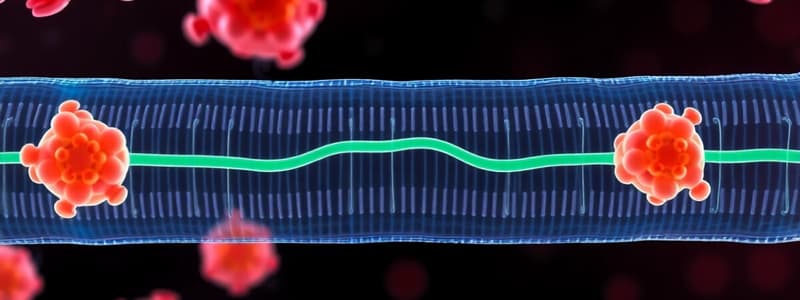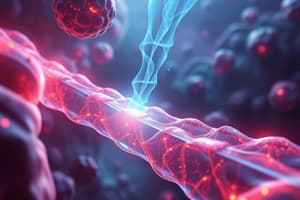Podcast
Questions and Answers
What best describes the direction of solute movement during diffusion?
What best describes the direction of solute movement during diffusion?
How do osmosis and diffusion primarily differ?
How do osmosis and diffusion primarily differ?
Which of the following transport methods requires energy?
Which of the following transport methods requires energy?
Which of the following processes involves the engulfing of materials into the cell?
Which of the following processes involves the engulfing of materials into the cell?
Signup and view all the answers
What is a key characteristic of facilitated diffusion?
What is a key characteristic of facilitated diffusion?
Signup and view all the answers
Which of the following methods of transport involve moving substances across the plasma membrane? (Select all that apply)
Which of the following methods of transport involve moving substances across the plasma membrane? (Select all that apply)
Signup and view all the answers
Describe how water molecules diffuse in the process of osmosis.
Describe how water molecules diffuse in the process of osmosis.
Signup and view all the answers
Compare osmosis and diffusion in terms of the type of particles that move.
Compare osmosis and diffusion in terms of the type of particles that move.
Signup and view all the answers
Solute moves ______ the concentration gradient.
Solute moves ______ the concentration gradient.
Signup and view all the answers
Study Notes
Comparison of Substances Crossing the Plasma Membrane
- Diffusion: Movement of solutes from high to low concentration without energy input.
- Osmosis: Special case of diffusion; focuses on the movement of water molecules across a semi-permeable membrane.
- Facilitated Diffusion: Involves carrier proteins to help specific molecules pass through the membrane, still moving from high to low concentration.
- Active Transport: Requires energy (ATP) to move substances against their concentration gradient (from low to high concentration).
- Filtration: Movement driven by pressure differences, allowing solutes and solvents to pass through a membrane.
- Endocytosis: Process by which cells engulf substances, forming vesicles to bring materials into the cell.
- Exocytosis: Reverse of endocytosis; vesicles inside the cell fuse with the plasma membrane to release their contents outside.
Passive Transport
- Passive transport mechanisms do not require cellular energy.
- Osmosis involves water molecules, while diffusion generally refers to solute movement.
Key Differences: Osmosis vs Diffusion
- Osmosis specifically involves water, while diffusion refers to solutes.
- In osmosis, the concentration gradient for solvent (water) dictates movement, whereas diffusion can involve various types of particles.
Concentration Gradient
- Substances move along their concentration gradient (from high to low concentrations), driven by natural tendencies toward equilibrium.
Comparison of Substances Crossing the Plasma Membrane
- Diffusion: Movement of solutes from high to low concentration without energy input.
- Osmosis: Special case of diffusion; focuses on the movement of water molecules across a semi-permeable membrane.
- Facilitated Diffusion: Involves carrier proteins to help specific molecules pass through the membrane, still moving from high to low concentration.
- Active Transport: Requires energy (ATP) to move substances against their concentration gradient (from low to high concentration).
- Filtration: Movement driven by pressure differences, allowing solutes and solvents to pass through a membrane.
- Endocytosis: Process by which cells engulf substances, forming vesicles to bring materials into the cell.
- Exocytosis: Reverse of endocytosis; vesicles inside the cell fuse with the plasma membrane to release their contents outside.
Passive Transport
- Passive transport mechanisms do not require cellular energy.
- Osmosis involves water molecules, while diffusion generally refers to solute movement.
Key Differences: Osmosis vs Diffusion
- Osmosis specifically involves water, while diffusion refers to solutes.
- In osmosis, the concentration gradient for solvent (water) dictates movement, whereas diffusion can involve various types of particles.
Concentration Gradient
- Substances move along their concentration gradient (from high to low concentrations), driven by natural tendencies toward equilibrium.
Studying That Suits You
Use AI to generate personalized quizzes and flashcards to suit your learning preferences.
Related Documents
Description
This quiz focuses on the various methods by which substances cross the plasma membrane, including diffusion, osmosis, facilitated diffusion, active transport, filtration, endocytosis, and exocytosis. Evaluate your understanding of these transport mechanisms and how they differ from one another.




